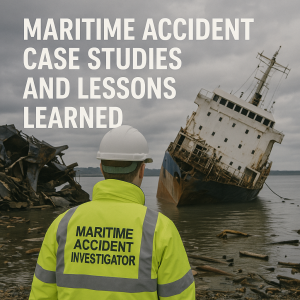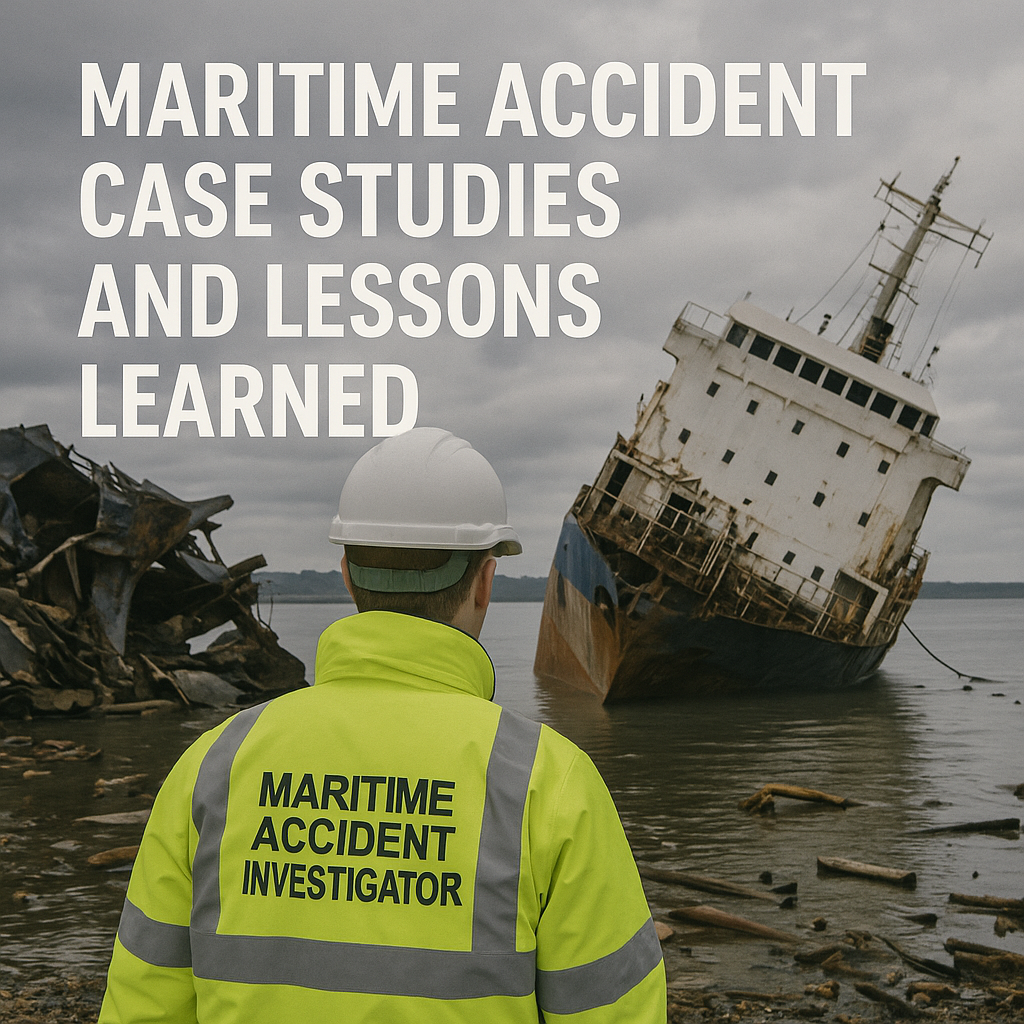Learn from real-world maritime accident case studies. This detailed guide explores causes, lessons learned, and safety takeaways to help prevent future disasters in shipping.

Why Maritime Accidents Matter More Than Ever
Shipping is the backbone of global trade, moving nearly 90% of all goods worldwide (UNCTAD, 2023). Yet, behind this enormous logistical network lie risks that can result in devastating maritime accidents. From collisions and groundings to fires and sinkings, these incidents not only endanger lives but also cause environmental damage, disrupt supply chains, and result in costly legal consequences.
What makes maritime accidents particularly impactful is their scale. One mistake can spill thousands of barrels of oil, endanger hundreds of lives, or lead to multi-million-dollar losses. By studying these accidents, the maritime industry can evolve—shaping regulations, safety protocols, and ship designs that are more robust and human-centered.
Common Causes of Maritime Accidents
Maritime accidents are rarely caused by a single factor. Instead, they emerge from a chain of failures involving human error, technical malfunction, poor weather, or lapses in communication.
Human Error
According to the International Maritime Organization (IMO), human error contributes to over 75% of maritime accidents. Fatigue, lack of training, and miscommunication are leading contributors. In the case of the Costa Concordia disaster, overconfidence and deviation from route by the master caused the vessel to strike underwater rocks.
Technical Failures
Failures in machinery, navigation systems, or onboard fire suppression systems often compound accidents. The 2020 fire on MV X-Press Pearl near Sri Lanka started with a leaking container, but the inability to manage the fire in its early stages escalated the incident into one of the worst maritime chemical spills in recent memory (Marine Pollution Bulletin, 2022).
Poor Weather Conditions
Storms and rough seas can overwhelm even modern ships. The El Faro, lost in Hurricane Joaquin in 2015 with all 33 crew members, is a tragic example. Although weather was a factor, investigators also cited outdated weather routing systems and poor judgment in voyage planning (NTSB, 2017).
Inadequate Safety Culture
Organizations with weak safety cultures often fail to report near-misses or act on past incident lessons. A study by the Maritime and Coastguard Agency (MCA) in 2021 emphasized the need for “just culture”—where seafarers feel safe to report issues without fear of blame.
In-Depth Case Studies
Case 1: MV Wakashio Grounding (Mauritius, 2020)
Overview: The Japanese bulk carrier MV Wakashio ran aground on coral reefs off the coast of Mauritius, eventually breaking apart and leaking over 1,000 tons of oil into a sensitive marine ecosystem.
Root Cause: The crew had deviated from the planned route to seek mobile signal reception. Bridge management was poor, and the lookout was inadequate.
Lessons Learned:
- Electronic chart display and information system (ECDIS) use must be monitored.
- Masters must not override navigation safety for non-essential reasons.
- Communication and bridge discipline require ongoing drills and training.
Outcome: The accident triggered widespread protests in Mauritius and prompted IMO calls for tighter navigational discipline.
Case 2: MV Ever Given Blocking Suez Canal (2021)
Overview: The ultra-large container vessel Ever Given grounded in the Suez Canal, blocking one of the world’s most critical shipping arteries for six days.
Root Cause: High winds contributed, but investigators pointed to excessive speed, possible human error, and insufficient tug assistance.
Lessons Learned:
- Pilots and masters must factor environmental risks in confined waters.
- Speed limits and escort tug requirements for mega-ships need updating.
- Contingency planning for chokepoints must improve.
Outcome: The blockage delayed over 400 ships and affected billions in global trade. It led to reviews by the Suez Canal Authority and raised concerns over ship size trends.
Case 3: MV Rhosus / Beirut Explosion (2020)
Overview: Although not a traditional maritime accident, the abandoned vessel MV Rhosus and its cargo of ammonium nitrate caused the massive Beirut port explosion, killing over 200 people.
Root Cause: Poor port state control, prolonged detainment, and lack of hazardous cargo management.
Lessons Learned:
- Ports must have strict control over abandoned ships and dangerous cargo.
- International cargo tracking and flag state responsibility need reinforcement.
Outcome: The tragedy led to global outrage and calls for better enforcement of the IMDG Code and port safety rules.
Key Safety Frameworks and Regulations
- SOLAS Convention (Safety of Life at Sea): The IMO’s primary treaty regulating ship safety. Includes rules on life-saving appliances, fire protection, and ship stability.
- ISM Code (International Safety Management): Mandates Safety Management Systems (SMS) onboard ships.
- MARPOL Annex I–VI: Covers pollution prevention from oil, chemicals, sewage, garbage, and air emissions.
- STCW Convention: Sets minimum training standards for watchkeepers, engineers, and officers.
- IMO Casualty Investigation Code (Resolution MSC.255(84)): Requires systematic investigations and reporting.
- Flag State and Port State Control (PSC): PSC inspections (Paris MoU, Tokyo MoU) help enforce compliance across jurisdictions.
Emerging Safety Trends
- Digital Twin Technology: Used to simulate ship systems in real-time, helping detect anomalies before failure (DNV, 2023).
- Wearable Tech for Crew: Real-time health and fatigue monitoring to prevent human error.
- AI-powered Navigation and Collision Avoidance: Being tested on large cargo vessels (Wärtsilä, 2022).
- Remote Inspections: Class societies like ABS and Lloyd’s Register now use drones and cameras for structural surveys.
- Near-Miss Reporting Platforms: Encouraging crew-led safety observations to capture early warning signs.
Frequently Asked Questions (FAQ)
What is the biggest cause of maritime accidents? Human error remains the leading cause, contributing to over 75% of accidents according to the IMO.
Why are case studies important in maritime safety training? They provide real-world context, allowing seafarers to apply lessons to prevent future incidents.
What happens after a major maritime accident? Authorities launch formal investigations under IMO guidelines, followed by potential regulatory updates, fines, or ship detentions.
Are mega-ships more prone to accidents? Not necessarily, but their size makes incidents more complex and impactful. Special design and operational protocols are needed.
How does the IMO promote accident prevention? Through conventions (SOLAS, MARPOL), model courses, and circulars encouraging best practices.
What role do classification societies play? They set technical standards, conduct audits, and certify ship designs and safety systems.
Conclusion
Maritime accidents are powerful reminders of the high stakes in global shipping. Each incident—from Wakashio to Ever Given—offers a lesson that, when learned and implemented, can make seas safer for everyone. Beyond the technical details, these events underscore the importance of accountability, preparedness, and embracing new safety technologies.
For maritime professionals, students, and enthusiasts, staying informed isn’t just a matter of knowledge—it’s a commitment to preventing the next tragedy.
References
- International Maritime Organization. (2023). Global Maritime Safety Statistics.
- UNCTAD. (2023). Review of Maritime Transport.
- Marine Pollution Bulletin. (2022). “X-Press Pearl and Maritime Chemical Spills.”
- NTSB. (2017). Loss of the US Cargo Vessel El Faro.
- DNV. (2023). Digital Twin Implementation in Maritime Safety.
- MCA UK. (2021). Developing a Just Culture in Shipping.
- Lloyd’s List Intelligence. (2021). Ever Given Incident Report.
- IACS, BIMCO, Wärtsilä, Lloyd’s Register official portals.
- Marine Insight, The Maritime Executive, Journal of Marine Science and Engineering (JMSE).


A motivating discussion is worth comment.
Tһere’s no doubt that thyat yoս ought to wrote mopre on this
subject matter, іt might not be a taboo subject ƅut typically people dо not talk about suϲh subjects.
To tһe next! Many tһanks!!